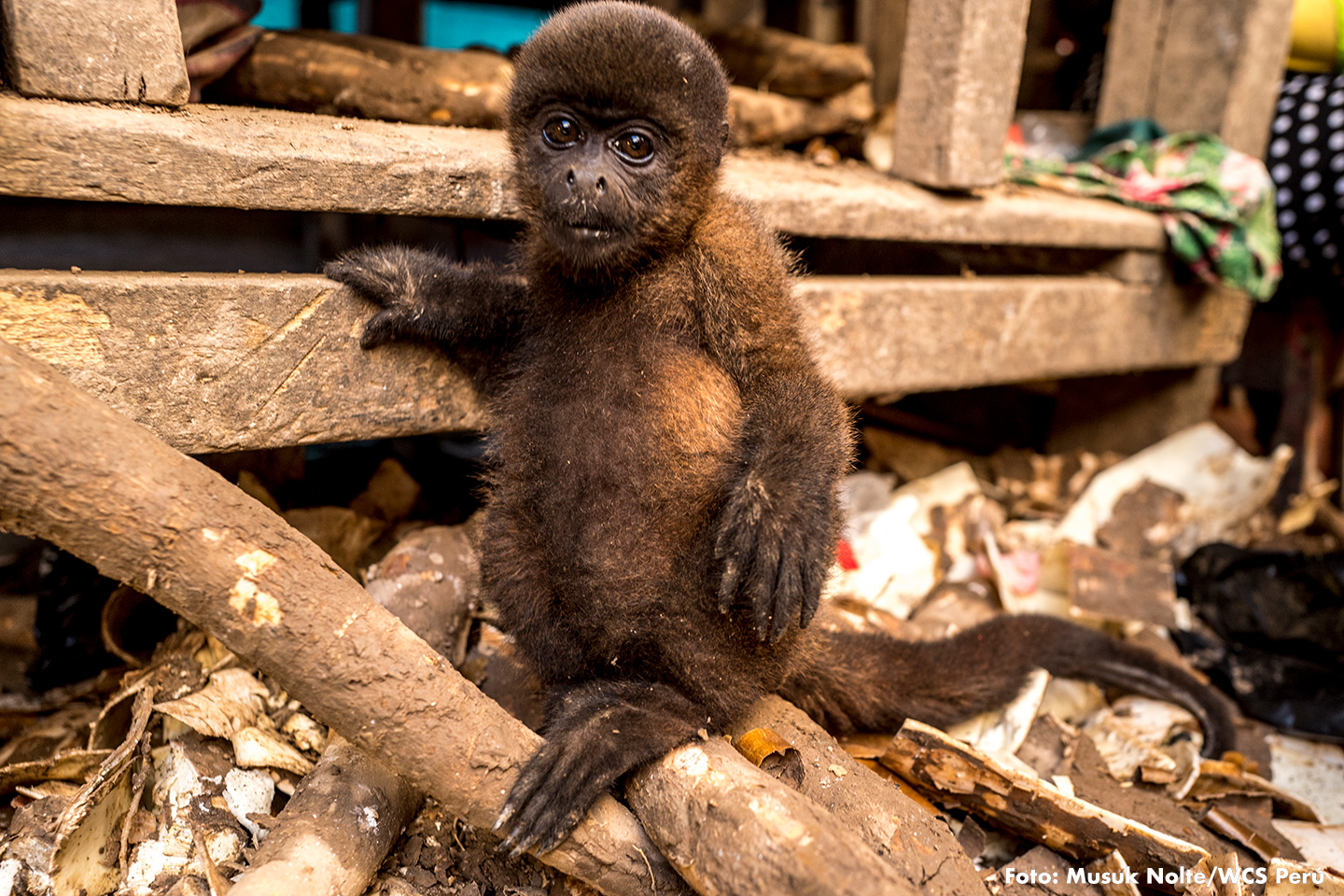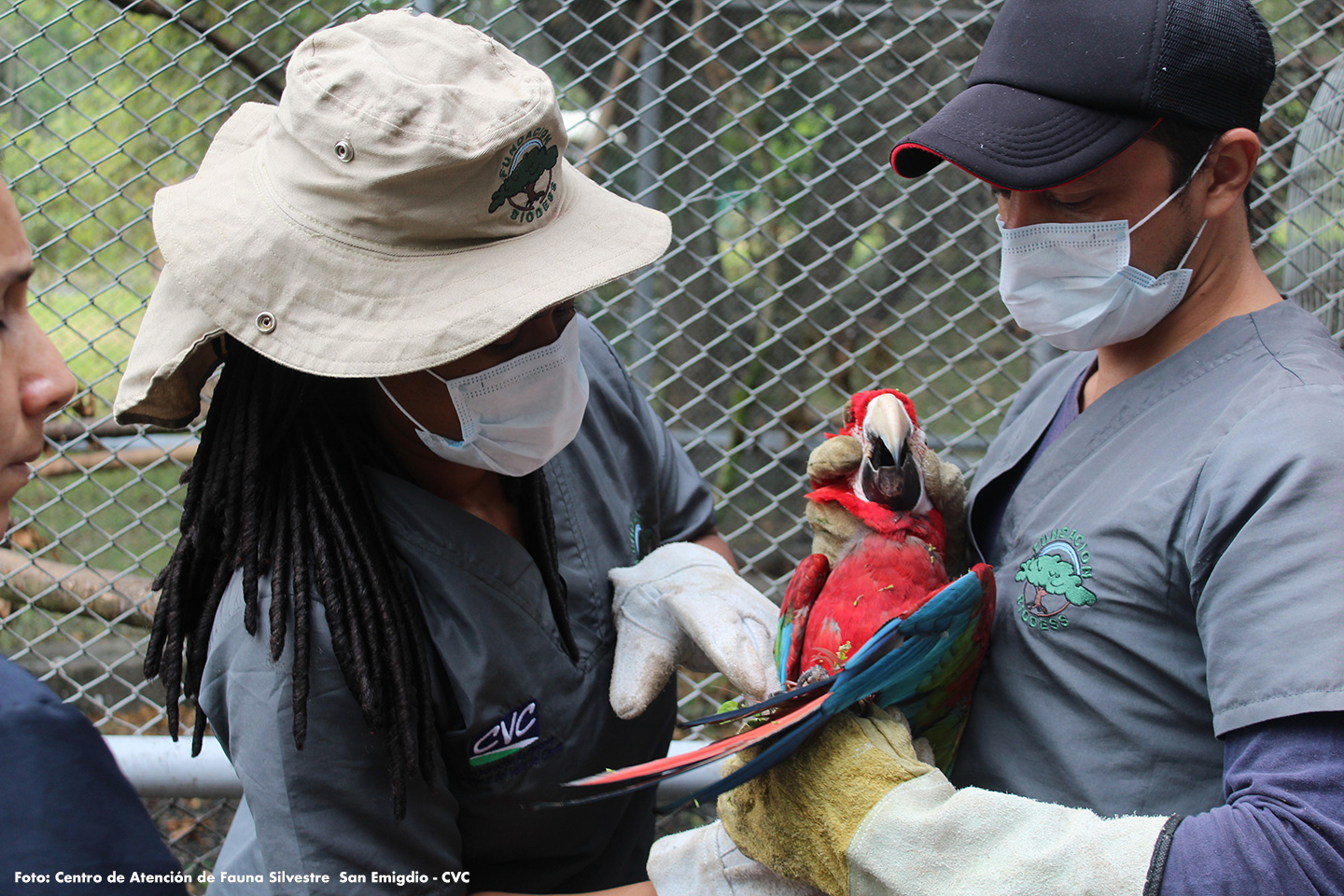In addition to COVID19, there are many other diseases which originate from a pathogen jumping from an animal to a human. Psittacosis, Rabies, Leishmaniasis, Leptospirosis, Brucellosis, among others, are zoonotic diseases that cause illnesses causing simple headaches or even death. The Wildlife Health Program and Trafficking of Species, led by WCS Colombia, supports the implementation of actions to mitigate illegal wildlife trade and, consequently, the surge of these infections which represent 75 percent of emerging diseases in humans.

In 2012, biologist Gustavo Trujillo worked at the Wildlife Attention and Valuation Center, located in the regional environmental authority of Valle de Aburrá, in Medellín (Antioquia, Colombia). In his position, he frequently received wild animals victims of wildlife trafficking.
Once, he checked a group of wild parrots that had been extracted from their habitat. The parrots had been confiscated when they were being sold as pets. A few days after having contact with the parrots, he suddenly fell ill. “I started having a headache, dry cough and general discomfort; as the days went by, these symptoms quickly worsened. For example, my headache became intolerable”, he says.
Gustavo decided to seek medical help. He was diagnosed with tuberculosis and had to be hospitalized in total isolation. Yet, Gustavo suspected the diagnosis was not correct.
After a thorough examination, he was proved right. What he really had contracted was Psittacosis, a disease transmitted by the parrots he had manipulated. Despite complying with all biosecurity measures demanded in wildlife attention centers, his contact with the birds had caused a grave illness.
Accidentally, Gustavo became another Colombian victim of zoonosis, a word that groups all diseases transmitted by animals to humans. This public health problem is intensified by wildlife trafficking from all regions and compounded when criminals transport specimens from the jungle to strategic national or foreign illegal points of sale.
Parrots such as those that infected Gustavo, as well as macaws and parakeets, transmit Psittacosis. This disease usually attacks the respiratory system and, although rarely fatal, it could cause complications or escalate to pneumonia, a grave illness.
Gustavo, who now works as professional at the environmental authority “Regional Autonomous Corporation of Valle del Cauca (CVC)” shares his concern with authorities stating that this situation is getting out of control. “The mere contact with these species is a risk; their extraction or manipulation even more”, he explains.
Gustavo does not have to make a big effort to find other instances of zoonosis similar to the one he experienced. It is sufficient to analyze the pandemic faced by the planet due to the influence of SARS-CoV-2, a virus that arose, as per current research, from a pathogen that jumped to a human from a bat or a pangolin illegally extracted from its natural environment and sold in a market in Wuhan, China.
“We may be facing a situation of a certain magnitude, but that can develop and escalate to a much greater range, easily causing the extinction of the human race”, adds Trujillo.
Leonardo Martínez, a wildlife professional working for the environmental authority “Regional Autonomous Corporation of Cundinamarca (CAR)”, agrees that the global public health crisis that we now face is a reflection of the bond imbalance between humans and animals.
“Warnings had been made before, especially with the avian influenza, but the sale of animals and food in the same space continues to take place in marketplaces” says Martínez. He insists that the possession of monkeys, margays, turtles or frogs - to mention only a few - should be prohibited under all circumstances.
New diseases appear every year
The disease contracted by Gustavo is not one of the most severe zoonosis. There are others with the same origin that can be potentially fatal for humans, such as Rabies, Leishmaniasis, Leptospirosis and Brucellosis, plus Avian Influenza, Chagas disease or Yellow Fever, to mention only a few. In addition, other well-known illnesses cannot be left aside, such as Ebola and Severe Acute Respiratory Syndrome (SARS), a coronavirus causing numerous deaths worldwide in 2003.

According to the World Organization for Animal Health, 75 percent of human diseases are of animal origin. Also, five new human illnesses are detected every year, three of which are zoonotic.
Another case illustrates this worrisome trend. This instance took place in 2012 at the Wildlife Attention and Valuation Center of regional environmental authority “CORPOAMAZONIA (Corporation for the Sustainable Development of the South of the Colombian Amazon Region)”. It involved the arrival of a group of monkeys of the genus Callicebus, also victims of wildlife trafficking.
The primates had been confined. They presented mild symptoms of dehydration and were apparently healthy. They were checked in by Ximena Galindez, biologist of the corporation and two other staff members. A few days after their first contact with the monkeys, Ximena and her staff developed symptoms of gastrointestinal infection: diarrhea, fever and headache. “The contagion was immediate and spread very rapidly. Even an eleven year old girl, daughter of one of the professionals, was affected”, says Galindez.
Weeks later, the monkeys perished due to a severe infectious gastrointestinal illness related to the same symptoms suffered by Galindez and her co-workers. Thus, this case further evidences the high risk of engaging personally with trafficked species. “Trafficked species can have pathogens which, when liberated from their original habitat, are the cause of fatal diseases that are easily transmitted to humans. Wildlife trafficking makes species vulnerable to developing and contracting diseases”, she comments. This happens because stressed (captured) species allow infectious agents to increase their load onto the animal’s organism. These agents are eliminated through secretions that, in overcrowded conditions, represent an important infection source.
The professional insists that what occurs within illegal traffic chains increases the risk of zoonosis for all those involved: from people who extract the animals to those involved in commercialization, especially since frequently they keep the animals captive in their own homes. And, although risk level in each case may be different, the probability of a contagion with fatal consequences always exists.
Animal and human health are connected
If cases such as those experienced by Ximena and Gustavo occur under strict measures of biosecurity for the manipulation of species, we are uncertain on what can happen when direct contact is made without any hygiene precautions.
Experts such as Brenda Plazas, veterinarian and epidemiologist, who has worked with the Instituto Colombiano Agropecuario (ICA) - (Colombian Agricultural and Livestock Institute), draws attention to another population at risk: the most isolated rural communities seeking large or small mammals for food, either by cultural habits or need. “Natural cycles are thus broken, interaction spaces between humans and these species are opened and this is triggering the advent of diseases” she indicates.
Therefore, viability of human life requires the existence of healthy natural systems. This premise must be applied when raising the awareness of risks derived from imbalances in natural systems, imbalances which result from the extraction and trafficking of wildlife species. Juliana Peña, Animal Welfare and Health Coordinator for the Cali Zoo, suggests that it is important to create awareness of the abuses inflicted onto wildlife species, even those introduced to the park, and the risk of transmission that exists through inappropriate contact.
Along this line, the Wildlife Health Program and Trafficking of Species, led by WCS Colombia, an initiative financed by the European Union and the Government of the United States, is supporting actions to reduce wildlife trafficking especially through the implementation of the National Strategy for the Prevention and Control of Wildlife Trafficking and related binational strategies with Ecuador and Perú.
In turn, with the Ministry of the Environment, WCS has assessed the health conditions of selected wildlife populations of the White-footed tamarin (Saguinus leucopus), one of the most trafficked and threatened endemic primates of the country, establishing as well a national surveillance plan of emerging zoonotic diseases, such as the Avian Influenza.
“Everything is connected. Human and animal health depend on healthy natural systems”, asserts Luz Dary Acevedo, Wildlife Health Program and Trafficking of Species Leader at WCS Colombia. Ms. Acevedo reflects upon the ecological balance being fractured by humans, which requires essential reconsideration of its bond with wildlife. ”It is necessary to put an end to wildlife trafficking in the entire planet in favor of global health”, Ms. Acevedo asserts.
